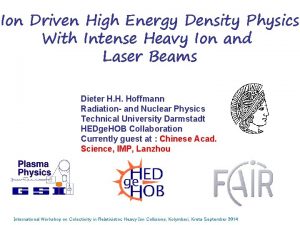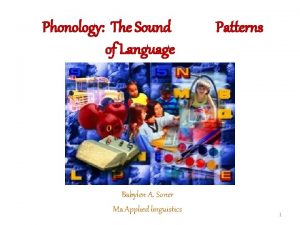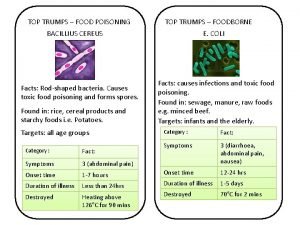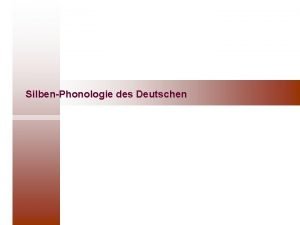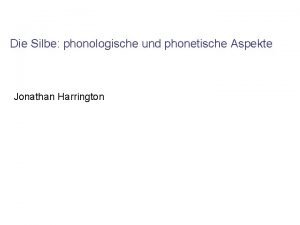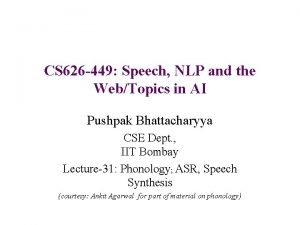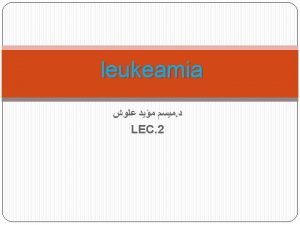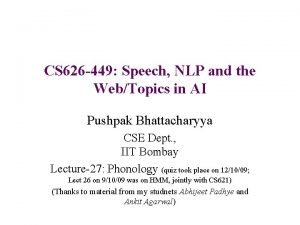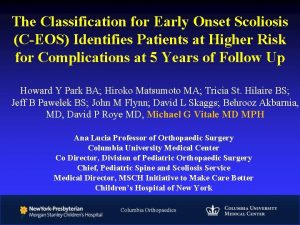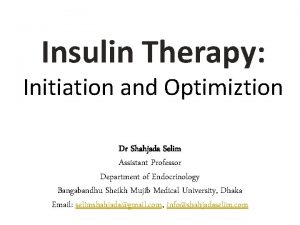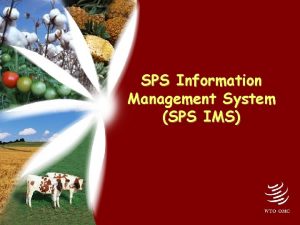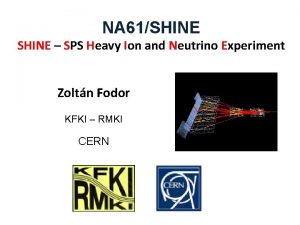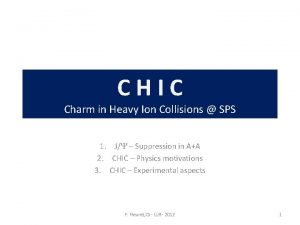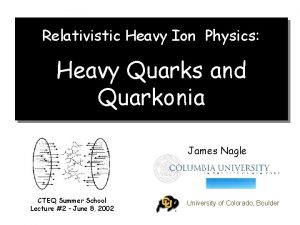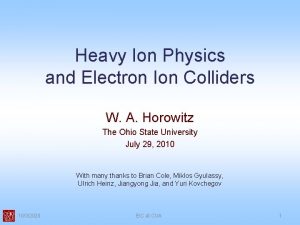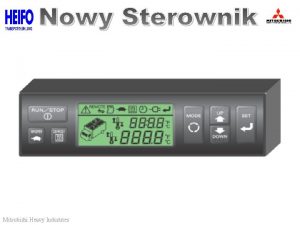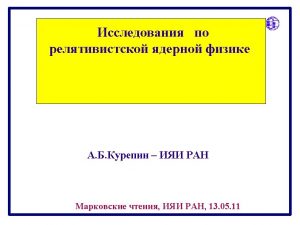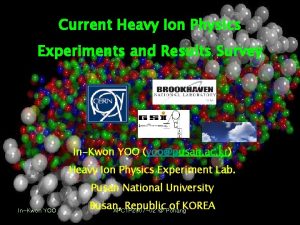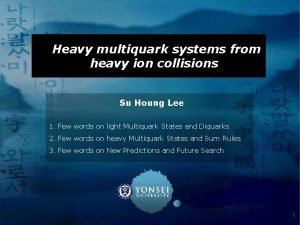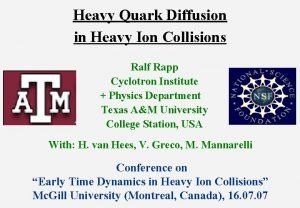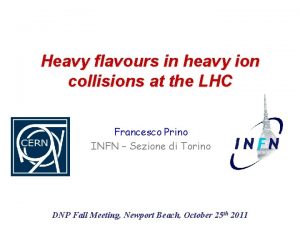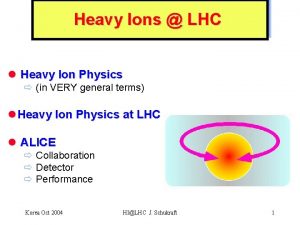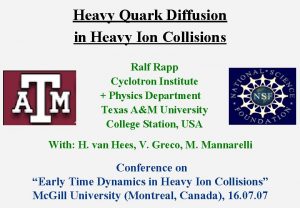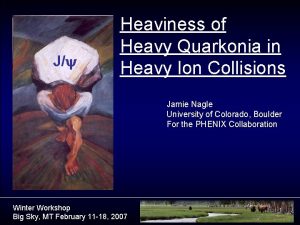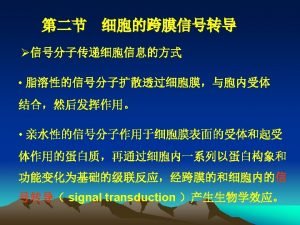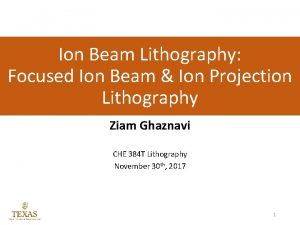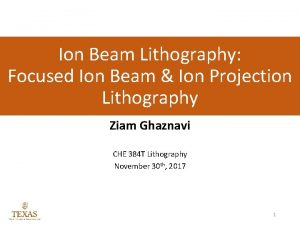The SPS Heavy Ion experiments and the onset



























- Slides: 27

The SPS Heavy Ion experiments and the onset of deconfinement A. Sandoval, Instituto de Física, UNAM, Mexico (for the NA 49 collaboration) • Introduction – phase diagram of hadronic matter • Onset of deconfinement in central Pb+Pb collisions at SPS energies • Study of fluctuations and search for the critical point in NA 49 1

Phase diagram of hadronic matter RHIC critical end point Fodor, Katz JHEP 04, 50(2004) SPS • QCD considerations suggest a first order phase boundary ending in a critical point • hadrochemical freeze-out points are obtained from particle yields via statistical model fits • T and μB approach the phase boundary and the estimated critical point location at the SPS • evidence of phase transition in hadron production systematics ? • indications of a critical point in fluctuations ? 2

QCD predicts quark, gluon deconfinement in high temperature and/or density hadron matter • hadrons overlap at densities > 0. 5 fm-3 → deconfinement (Collins, Perry 1974) • quantitative predictions from Lattice QCD (non-perturbative) Karsch, Laermann hep-lat/0305025 (for μq = 0) such conditions can be reached for a few fm/c in a large nucleus volume in relativistic heavy ion collisions already at the SPS 3

Pb+Pb collisions at top SPS energy • Program ran from 1991 -2002 with Pb ions at 160 Ge. V/A • Many experiments: NA 45, NA 49, NA 50, NA 57, NA 60, WA 97, WA 98 • initial energy density exceeds the critical value predicted by lattice QCD ( ≈ 1 Ge. V / fm 3 ) • signatures for deconfinement observed at SPS in 2000 – strong radial and anisotropic flow of produced matter – strangeness enhancement – J/Ψ, Ψ’ yield suppression – di-lepton enhancement, ρ0 modification • unfortunately signatures not specific for deconfinement 4

NA 49 Experiment • NA 49 search for a threshold by varying the energy for the largest collision system (central Pb+Pb reactions) • SPS energy scan: 20, 30, 40, • • 80, 158 Ge. V/nucleon (√s. NN = 6. 3, 7. 6, 8. 7, 12. 3, 17. 3 Ge. V) [completed in 2002] 5

The NA 49 Detector Target: Pb foil, 20 cm liquid H 2 VCAL detects projectile spectators Δp/p 2 = 7 (0. 3) • 10 -4 (Ge. V/c)-1 (VTPC-1, VTPC+MTPC) Particle identification: d. E/dx (3 – 6 %), TOF (~ 60 ps) decay topology (K 0 s , Λ, Ξ, Ω) √s. NN = 6. 3, 7. 6, 8. 7, 12. 3, 17. 3 Ge. V 2. 5 < p < 10 Ge. V/c TOF + d. E/dx at midrapidity p > 7 Ge. V/c d. E/dx forward rapidity 6

Particle yields – statistical model (fits by F. Becattini et al, PRC 69(2004)024905) • hadron species populated ( NA 49 data ) approximately according to phase space probabilities (max. entropy) (Fermi, Hagedorn) • strangeness sector not fully saturated (Rafelski) • statistical model successful in A+A, p+p, e++e─ • parameters: T, μB, γS, V V=3400 fm 3 7

Total pion yields (C. Alt et al. , PRC 77, 024903(2008) • increase of <π>/<NW> with energy gets steeper in the SPS range • π deficit changes to enhancement compared to p+p • pions are most abundant produced particle species measure of produced entropy in statistical models SMES: statistical model of the early stage (Gazdzicki, Gorenstein : Acta Phys. Pol. B 30 (1999) 2705) consistent with x 3 increase of initial d. o. f. , g, at SPS 8

Ratio of kaon to pion yields at SPS energies produced s quarks are mostly contained in kaons (equally in K+ and K 0), s quarks are shared between K-, K 0 and hyperons → <K+> a measure of total strangeness yield sharp peak observed in relative strangeness production <K+>/<π+> at SPS not reproduced by hadronic models 9

onset of deconfinement in central Pb+Pb collisions at the SPS final NA 49 results: C. Alt et al. , PRC 77, 024903 (2008) relative strangeness production inverse m. T slope parameter SPhe. RIO • rapid changes of hadron production properties at low SPS energy • only models with deconfinement at the early stage describe data • deconfinement reached in central Pb+Pb collisions above ≈ 30 AGe. V 10

Ratio of strange hadron to pion yields hadro nic AGS SPS mixed partonic strangeness to pion ratio peaks sharply at the SPS SMES explanation: - entropy, number of s, s quarks conserved from QGP to freeze-out - ratio of (s + s) / entropy rises rapidly with T in the hadron gas - Es drops to the predicted constant QGP level above threshold of deconfinement : suggests onset of deconfinement at SPS P. Seyboth: Search for the critical point of QCD at the CERN SPS 25 th Winter Workshop on Nuclear Dynamics - Big Sky, USA, 1 -7/2/2009 11

Total yield of s, s quarks estimated using: measured yields and isospin symmetry + correction for unmeasured yields from statistical HG model predictions HG SMES increase of yields with energy changes slope at 30 A Ge. V sharp peak, then under-saturation of strangeness content 12

Average transverse mass Au. Au Pb. Pb Au. Au • Increase of <m. T> for abundant final state particles ( π, K, p) slows sharply at the lowest SPS energy • consistent with approximately constant pressure and temperature in a mixed phase system (L. van Hove, PLB 89 (1982) 253; M. Gorenstein et al. , PLB 567 (2003) 175) 13

Inverse slope parameters • the step-like feature observed, not seen for p+p collisions and models without phase transition • hydrodynamic model with deconfinement phase transition starting at the SPS describes measurements (model SPhe. RIO: S. Hama at al. , Braz. J. Phys. 34 (2004) 322) 14

energy dependence of fireball parameters blast wave parameterisation (Retiere, Lisa PRC 70, 044907(2004) • constant radius • 2 · RPb, Au slow increase of • freeze-out T • surface flow ρ0 • lifetime τ 15

Anisotropic flow v 2 of pions: energy dependence AGS SPS RHIC σ/σT ≈ 10 – 35 % • change from out-of-plane (shadowing) to in-plane (hydro) at AGS • rate of increase of v 2 slows between AGS and SPS • steady rise from SPS to RHIC (partly due to yield increase at higher p T ) 16

model interpretation of elliptic flow at SPS and RHIC Teaney, Lauret, Shuryak • QGP + hydrodynamic expansion PRL 86 (2001) 4783 • statistical hadronisation by quark coalescence • freeze-out via hadronic re-scattering stage (RQMD) RHIC SPS hydro model with QGP phase provides fair description of SPS and RHIC data 17

width of rapidity distribution sound velocity estimate of sound velocity cs Landau hydrodynamical model (E. Shuryak, Yad. Fiz. 16, 395(1972)) → sound velocity can be derived from measurements (H. Petersen and M. Bleicher, nucl-th/0611001) Minimum of sound velocity cs (softest point of Eo. S) around 30 A Ge. V 18

Phase space density from m. T spectra and BE correlations of π¯ S. Akkelin and Y. Sinyukov, Phys. Rev. C 73, 034908 (2006) plateau of the averaged phase space density at SPS energies may be associated with the onset of deconfinement 19

π¯π¯ BE correlations: radius parameters midrapidity, k. T = 0. 2 Ge. V/c AGS SPS RHIC • remarkably little change of Rside (fireball radius) and Rout • slow rise of Rlong (lifetime) • no indication of Rout >> Rside i. e. long duration of π emission (1 st order phase transition, soft point of Eo. S) • hydro models have problems; need of more sophisticated modelling of freeze-out 20

Search for the critical point in fluctuations effects of critical point are expected over a range of T, µB Y. Hatta and T. Ikeda, PRD 67, 014028 (2003) hydro predicts that evolution of the system is attracted to critical point M. Asakawa et al. , PRL 101, 122302 (2008) 21

Electric charge fluctuations • Smaller in a QGP than in a hadron gas (Jeon, Koch, Asakawa, Heinz, Müller) ΔΦq = Φq - Φq, gcc PRC 70, 064903(2004) Central Pb+Pb collisions 158 A Ge. V -0. 6< y <2. 4 Global charge conservation QGP signature probably erased by hadronisation (Bialas) or the effect of resonance decays (Zaranek) 22

Fluctuations of the event-by-event K/π ratio maximum likelihood fit for each event Beam Energy σ2 dyn = σ2 data – σ2 mixed ar. Xiv: 0808. 1237 Fluctuations increase at lower energy effect of onset of deconfinement ? M. Gorenstein et al. , PLB 585(2004)237 23

Beam Energy Fluctuations of the event-by-event (p + p)/π ratio ar. Xiv: 0808. 1237 The distribution of the E-by-E p/π ratio is narrower for data than mixed events. Effect of baryon resonance decay ? 24

Event-by-event fluctuations of multiplicity large fluctuations are expected if hadronisation occurs close to the QCD critical point M. Stephanov, K. Rajagopal, E. Shuryak, PRD 60, 114028(1999) Y. Hatta and T. Ikeda, PRD 67, 014028(2003) NA 49 C. Alt et al. , PRC 78, 034914 (2008) no peak for ω in central Pb+Pb collisions at the SPS 25

Conclusions • the study of the energy dependence shows there is evidence for the onset of deconfinement at 30 Ge. V/A – strange-non strange quark production – mean transverse mass – sound velocity – phase space density • the existence of the critical point of hadron matter is an important prediction of QCD that must be tested • predictions locate the critical point in the phase diagram region accessible with ion-ion reactions at SPS energies • no indications have been found in Pb+Pb collisions of critical fluctuations 26

The NA 49 Collaboration 27
 What does ratey stand for
What does ratey stand for Heavy ion
Heavy ion Ejemplo de fuerza ion ion
Ejemplo de fuerza ion ion Dipolo dipolo inducido
Dipolo dipolo inducido Que es fuerzas intramoleculares
Que es fuerzas intramoleculares Example of ion dipole
Example of ion dipole Continuous subcutaneous infusion
Continuous subcutaneous infusion Nph onset and peak
Nph onset and peak Regressive assimilation examples
Regressive assimilation examples Coronal consonants
Coronal consonants Onset coda and nucleus
Onset coda and nucleus Onset and coda examples
Onset and coda examples Lateinon
Lateinon Maximal onset principle example
Maximal onset principle example Food poisoning onset
Food poisoning onset Voice onset time
Voice onset time Silbenstruktur übung mit lösung
Silbenstruktur übung mit lösung Marginalization probability
Marginalization probability Gastroenterritis
Gastroenterritis Anaphylaxis onset
Anaphylaxis onset Sonoritätsprinzip
Sonoritätsprinzip Normal labour
Normal labour Webtopings
Webtopings Abrupt stormy onset
Abrupt stormy onset Maximal onset principle example
Maximal onset principle example Early onset scoliosis classification
Early onset scoliosis classification The sound patterns of language
The sound patterns of language Types of insulin
Types of insulin

